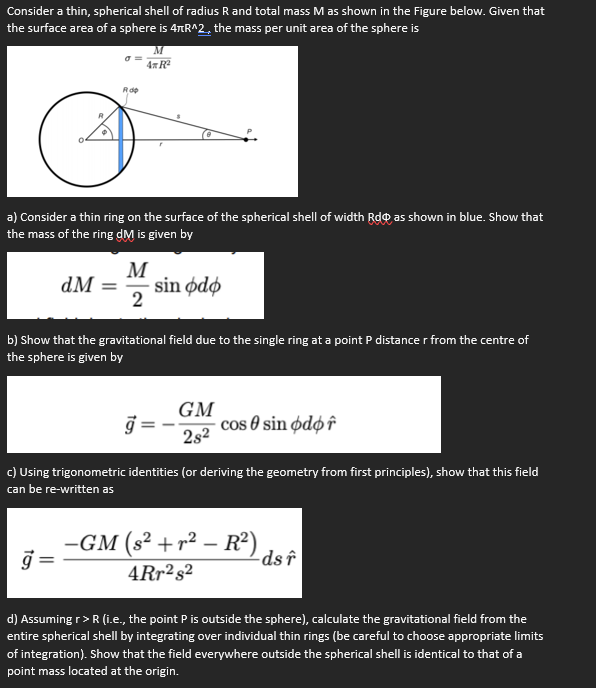Consider a thin, spherical shell of radius R and total mass M as shown in the Figure below. Given that the surface area of a sphere is 4nR^2, the mass per unit area of the sphere is 4x R Rde a) Consider a thin ring on the surface of the spherical shell of width Rdo as shown in blue. Show that the mass of the ring dM is given by M sin ødø 2 dM = b) Show that the gravitational field due to the single ring at a point P distance r from the centre of the sphere is given by j = GM cos 0 sin ødø î 2s2 c) Using trigonometric identities (or deriving the geometry from first principles), show that this field can be re-written as -GM (s² +r² – R²) -ds î 4Rr²s²
Consider a thin, spherical shell of radius R and total mass M as shown in the Figure below. Given that the surface area of a sphere is 4nR^2, the mass per unit area of the sphere is 4x R Rde a) Consider a thin ring on the surface of the spherical shell of width Rdo as shown in blue. Show that the mass of the ring dM is given by M sin ødø 2 dM = b) Show that the gravitational field due to the single ring at a point P distance r from the centre of the sphere is given by j = GM cos 0 sin ødø î 2s2 c) Using trigonometric identities (or deriving the geometry from first principles), show that this field can be re-written as -GM (s² +r² – R²) -ds î 4Rr²s²
University Physics Volume 1
18th Edition
ISBN:9781938168277
Author:William Moebs, Samuel J. Ling, Jeff Sanny
Publisher:William Moebs, Samuel J. Ling, Jeff Sanny
Chapter13: Gravitation
Section: Chapter Questions
Problem 82CP: Following the technique used in Gravitation Near Earth’s Surface, find the value of g as a function...
Related questions
Question

Transcribed Image Text:Consider a thin, spherical shell of radius R and total mass M as shown in the Figure below. Given that
the surface area of a sphere is 4nR^2, the mass per unit area of the sphere is
4x R
Rde
a) Consider a thin ring on the surface of the spherical shell of width Rdo as shown in blue. Show that
the mass of the ring dM is given by
M
sin ødø
2
dM =
b) Show that the gravitational field due to the single ring at a point P distance r from the centre of
the sphere is given by
j =
GM
cos 0 sin ødø î
2s2
c) Using trigonometric identities (or deriving the geometry from first principles), show that this field
can be re-written as
-GM (s² +r² – R²)
-ds î
4Rr²s²
d) Assuming r>R (i.e., the point P is outside the sphere), calculate the gravitational field from the
entire spherical shell by integrating over individual thin rings (be careful to choose appropriate limits
of integration). Show that the field everywhere outside the spherical shell is identical to that of a
point mass located at the origin.
Expert Solution
This question has been solved!
Explore an expertly crafted, step-by-step solution for a thorough understanding of key concepts.
Step by step
Solved in 4 steps with 1 images

Recommended textbooks for you

University Physics Volume 1
Physics
ISBN:
9781938168277
Author:
William Moebs, Samuel J. Ling, Jeff Sanny
Publisher:
OpenStax - Rice University

Astronomy
Physics
ISBN:
9781938168284
Author:
Andrew Fraknoi; David Morrison; Sidney C. Wolff
Publisher:
OpenStax


University Physics Volume 1
Physics
ISBN:
9781938168277
Author:
William Moebs, Samuel J. Ling, Jeff Sanny
Publisher:
OpenStax - Rice University

Astronomy
Physics
ISBN:
9781938168284
Author:
Andrew Fraknoi; David Morrison; Sidney C. Wolff
Publisher:
OpenStax


Foundations of Astronomy (MindTap Course List)
Physics
ISBN:
9781337399920
Author:
Michael A. Seeds, Dana Backman
Publisher:
Cengage Learning

Stars and Galaxies (MindTap Course List)
Physics
ISBN:
9781337399944
Author:
Michael A. Seeds
Publisher:
Cengage Learning